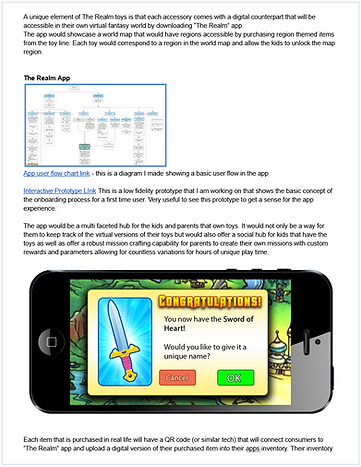UX Director
Project Overview
Product: The Realm
Company: Myself & Micheal CharyChao
Industry: Mobile games
Role: Creator, UX Designer, Artist
Timeframe: 6 Months
Platform: Iphone and Android
Defining the vision for my game
The idea for The Realm: A Smart Sword Adventure was born at the intersection of augmented reality (AR), mobile gaming, and physical toy swords, sparked by a vision to create a truly immersive fantasy experience. Observing the rise of AR in games like Pokémon GO and the enduring appeal of mobile role-playing games, I recognized an opportunity to blend these digital innovations with a tangible, interactive element—a Bluetooth-enabled toy sword.
This fusion allows players to physically engage in combat and exploration within a rich digital world, creating a unique hybrid experience. After researching existing games and toys, I found no other project combining AR, mobile platforms, and a smart sword in this way, revealing an unclaimed niche. The Realm fills this gap, offering players an unparalleled adventure that bridges the physical and digital, appealing to fantasy fans and tech enthusiasts alike.



UX Design stage 1: Research
Defining User Personas
The Realm is a fantasy mobile game integrated with a Bluetooth-enabled toy sword, targeting players who enjoy action-adventure, role-playing, and interactive physical-digital gaming experiences. The game emphasizes exploration, combat, and storytelling, appealing to both casual and dedicated gamers, particularly those interested in fantasy and interactive tech. To determine user personas for The Realm, a structured approach using market research and user analysis ensures personas reflect the target audience’s needs, motivations, and behaviors, guiding intuitive gameplay and seamless physical-digital integration.
Market research and user segmentation identify the target audience for The Realm. Analyzing similar games like Pokémon GO through surveys and X posts reveals key demographics: teens, tech-savvy adults, parents, and RPG enthusiasts. Psychographics, such as motivations for escapism or achievement, and technological comfort refine these segments, aligning personas with the game’s unique blend of swordplay and storytelling.
Persona creation synthesizes data into detailed profiles with names, ages, motivations, and pain points. The Teen Fantasy Gamer (Alex, 15) reflects teens’ love for mobile fantasy games, the Tech-Savvy Millennial (Priya, 28) targets gadget enthusiasts, the Parent of Young Gamer (Michael, 40) addresses family-friendly needs, and the Hardcore RPG Enthusiast (Jordan, 22) caters to narrative-driven gamers. Validated through playtesting, these personas guide features like intuitive controls and deep lore to maximize engagement.
Defining Use Cases




Having a firm understanding of who is using the product coupled with the requirments then gives way to creating use cases. A use case is a detailed description of the actions a user takes to accomplish their specific goal when using a product. Often a single product wil have multiple use cases per type of user. While it can be time consuming to document all of the possible use cases for a product, its good to at least define the main use cases that the average user will encounter and plan for those.
UX Design stage 2: Ideation
Mapping out our understanding of the Product
Once we have all the requirements and the basic use cases defined we moved to the Ideation stage and started working on product diagrams, and user flow diagrams. As is often the case by simply diagramming out what we think we are going to build, we find discrepancies in product vision across stakeholders and team leads.
This results in multiple iterations on the diagrams and an increasing understanding and clarity of what we need to build. Once we are satisfied that we have the correct diagram we share it out with the teams and use it as a benchmark for design discussions.
The user flow diagrams then serve as the blueprint
for beginning our wireframes of the software.

[ Whiteboard notes and design ideas were captured in loose quick sketches and then used as low fidelity prototypes to test the solutions quickly.]

Exploring the Bluetooth Wooden Sword Design
I collaborated with my project partner and we came to the conclusion that for rapid prototyping the toy peripheral making a wooden sword laser cut in multiple layers would be fast and allow us to create the necessary hollow structure for the Bluetooth technology.



Exploring the Bluetooth to app connection
My partner Michael CaryChao is an amazing technical genius and he did the programming for the app and the Bluetooth hardware. We got a rapid prototype working before moving into the final version of the app.
UX Design stage 3: Prototyping
Establishing Visual Style
In the beginning of the project I went with the name Dragon Hunters because I thought that there would be a dragon collection element similar to Pokemon Go. I worked on a simple prototype of the app to prove out the concept of how the game could work. The original design was done in Invision which has since closed and deleted all the users content. So this video is all I have of the intitial prototype.
Low Fidelity Exploration
In the beginning of the project I went with the name Dragon Hunters because I thought that there would be a dragon collection element similar to Pokemon Go. I worked on a simple prototype of the app to prove out the concept of how the game could work. The original design was done in Invision which has since closed and deleted all the users content. So this video is all I have of the intitial prototype.




